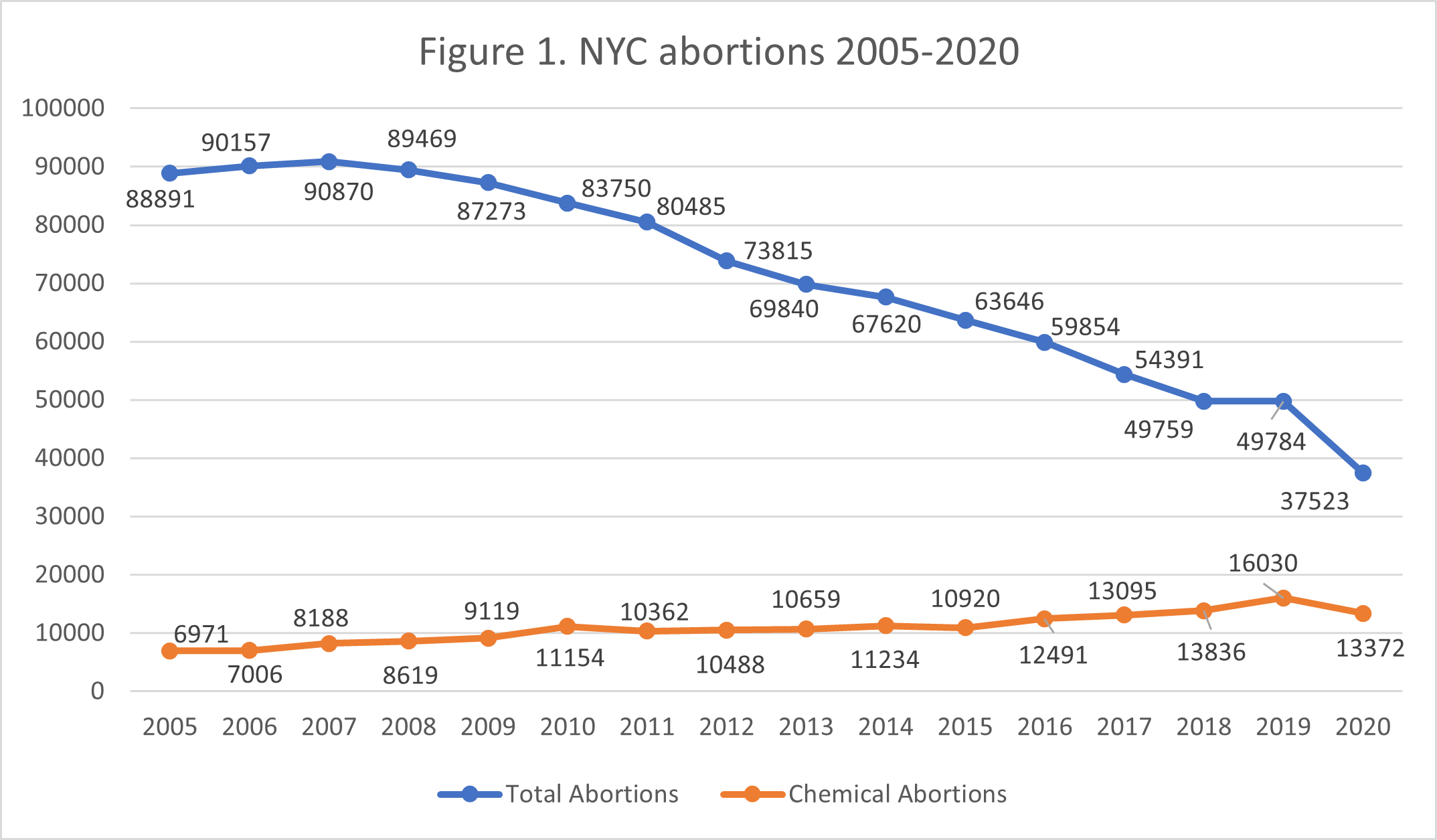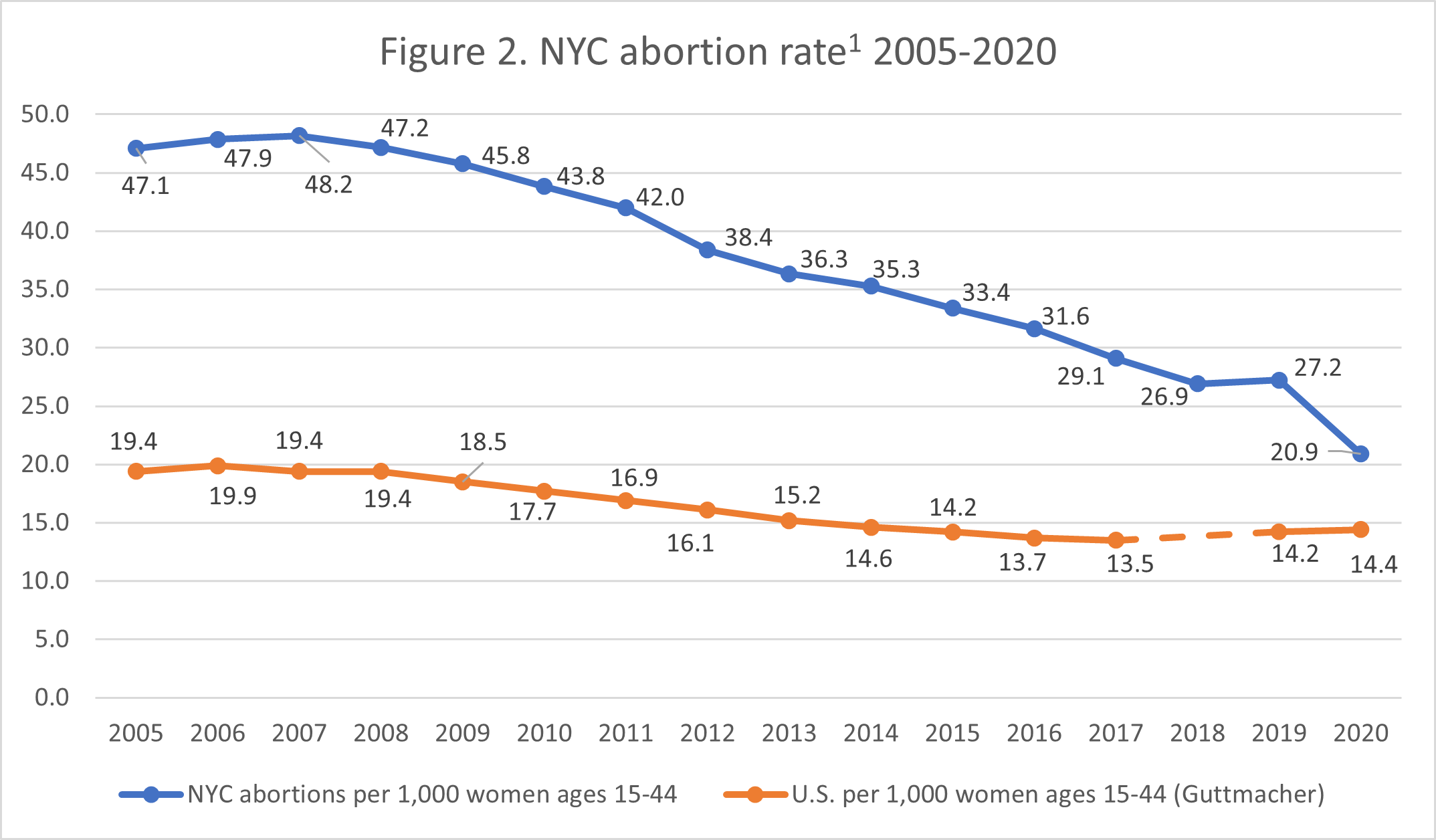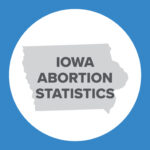Abortion Reporting: New York City (2020)
New York City’s 2020 abortion statistics were published online as part of the city’s vital statistics report in April 2023.
Statistics and Changes in New York City Abortions, 2019-2020

The report does not include information on Planned Parenthood’s New York City abortion market share.
Abortion Totals and Trends
New York City’s 2020 abortion statistics showed a decline in the number of abortions occurring in New York City from 2019 to 2020, with 37,523 abortions reported in the city in 2020, a decrease of 25 percent from 2019 (Fig. 1). There were 13,372 chemical abortions in New York City in 2020, a decrease of 17 percent from 2019. However, chemical abortions composed a higher percentage of total abortions in 2020 (36 percent) than they did in 2019 (32 percent). The Charlotte Lozier Institute (CLI) estimates that New York City’s 2020 abortion rate was 20.9 abortions per 1,000 women ages 15-44 (Fig. 2).
State Report Summary
Ninety-one percent of New York City abortions were performed on city residents in 2020: 28 percent were on residents from Brooklyn, 23 percent from Queens, 22 percent from the Bronx, 15 percent from Manhattan, and three percent from Staten Island. Eight percent of New York City abortions were performed on women who did not live in the city.
Eight percent of New York City abortions were obtained by girls under the age of 20, with more than five percent of total abortions on girls ages 18 and 19 and a little over two percent on girls ages 17 and younger. A quarter of the abortions were performed on women ages 20 to 24, and 29 percent were on women ages 25 to 29. Twenty-two percent were obtained by women ages 30 to 34, and 12 percent were on women ages 35 to 39. Five percent were on women ages 40 or older.
Non-Hispanic black women underwent the largest percentage of abortions in New York City in 2020, accounting for 37 percent of the total. Eleven percent of the abortions were obtained by non-Hispanic white women, and 26 percent were performed on Hispanic women. Four percent were performed on Asian or Pacific Islander women, and three percent were on women of other races. Race was not reported for 19 percent of the abortions. CLI estimates that New York City’s non-Hispanic black abortion rate was 35.5 abortions per 1,000 women ages 15 to 44, five times the non-Hispanic white rate of 6.8. Seventy-two percent of New York City abortions were on unmarried women, and 15 percent were on married women, while marital status was not reported for 13 percent of the abortions.
A majority, 55 percent, of New York City abortions were performed using suction curettage. Thirty-six percent were chemical. Seven percent of the abortions were performed via dilation and evacuation, and two percent were sharp curettage or dilation and curettage abortions. There were 34 hysterectomy or hysterotomy abortions and 29 intrauterine instillation abortions, while 37 abortions were performed using some other unspecified method.
Forty-five percent of the abortions reported in New York City occurred at six weeks of gestation or earlier. Twenty-eight percent were performed between seven and eight weeks, and 11 percent were reported between nine and 10 weeks’ gestation. Five percent occurred between 11 and 12 weeks, and four percent were reported between 13 and 15 weeks. Another four percent of New York City abortions occurred between 16 and 20 weeks’ gestation. There were 773 abortions (two percent of the total) reported at 21 weeks of gestation or later, higher than in many other reporting areas.
The largest portion of New York City abortions occurred in Manhattan (49 percent). Twenty-four percent were performed in Queens, 15 percent in Brooklyn, and 11 percent in the Bronx. Just over half a percent were performed on Staten Island. This data is different from the resident data described in the first paragraph of this section, as this data describes where abortions were performed in the city while the resident data describes the residency status of women who had abortions in New York City.
Pregnancy Outcomes by Race
The non-Hispanic black abortion ratio was much higher than the non-Hispanic white abortion ratio in New York City. There were 773.2 abortions per 1,000 live births to non-Hispanic black women in 2020, compared to 110.0 among non-Hispanic white women. Furthermore, these calculations likely underestimate the percentage of pregnancies ending in abortion because New York City abortion data is exceedingly incomplete, with race unreported for a large number of abortions.
| % of preg. ending in abortions | % of preg. ending in miscarriage | % of preg. ending in live births | |
| Non-Hispanic Black | 42% | 4% | 54% |
| Non-Hispanic White | 10% | 4% | 87% |
| Hispanic | 25% | 3% | 72% |
| Asian/Pacific Islander | 9% | 3% | 88% |
These percentages were calculated from data provided by New York City’s Bureau of Vital Statistics in Table PO21 “Pregnancy Outcomes, Pregnancy Outcome Rates, and Pregnancy Rates by Woman’s Age Group, Racial/Ethnic Group, and Borough of Residence, New York City, 2020.”
Legislative Changes
Following the overturn of Roe v. Wade in June 2022, New York City Mayor Eric Adams signed six bills (titled the NYC Abortion Rights Act) passed by the City Council. One major component of this Act, Int. 507-A, was to “provide FDA-approved medication for medication abortion, at no cost to a patient, at health clinics operated by DOHMH [Department of Health and Mental Hygiene].”
In January of 2023, New York City became the first city in the world to roll out this program and provide free abortion pills at a city run health clinic. The city had already been providing chemical abortion at 11 of its public hospitals. However, the new program started at a Bronx clinic and will eventually expand access to the dangerous regimen to three other clinics in Queens, Harlem and Brooklyn.
Other components of the NYC Abortion Rights Act touch on topics such as the reporting of nonresident births and abortions that occur in the city, creating a private right of action for interference with abortion access and conducting public education campaigns to inform the city about the “protections” available to them when to comes to accessing abortion. Another main focus of the legislation is mandating that city resources be barred from being used to “detain persons for performing or aiding with abortions or to cooperate with out-of-state entities related to abortions performed in New York state.”
State Ranking
In 2016, CLI evaluated abortion reporting across the country, and New York City was ranked at 31st best. New York City could improve its reporting by ensuring that abortion pills sent via the mail are reported to the city. This could be done by reviewing the city’s abortion reporting requirements to make sure that the requirements are applicable to all practitioners who prescribe an abortion-inducing drugs to New York women, regardless of where the abortion provider is physically located.


- Rates were calculated by CLI using the following formula: (total number of abortions performed in New York City ÷ number of resident women ages 15-44) x 1,000. Rates may differ slightly from previous CLI articles due to revised population estimates. Population estimates were obtained from CDC WONDER. Estimates for 2005-2009 are intercensal estimates of the July 1 resident population. Estimates for 2010-2020 are Vintage 2020 postcensal estimates of the July 1 resident population. Estimates were produced by the U.S. Census Bureau and the National Center for Health Statistics.























